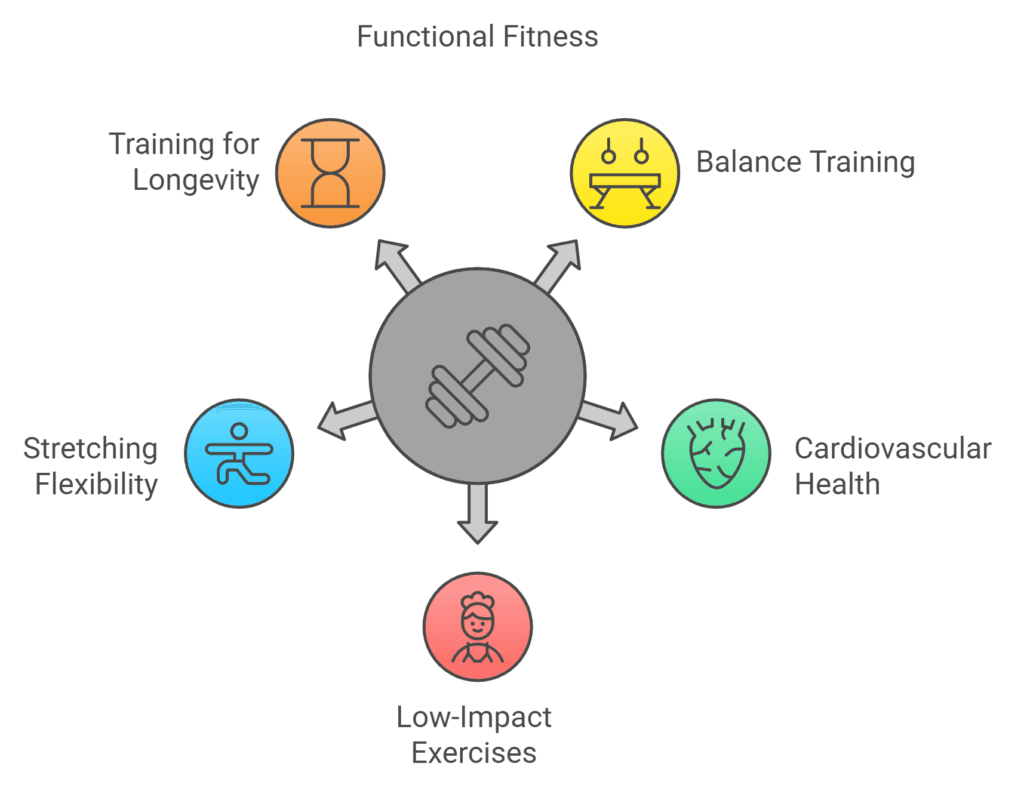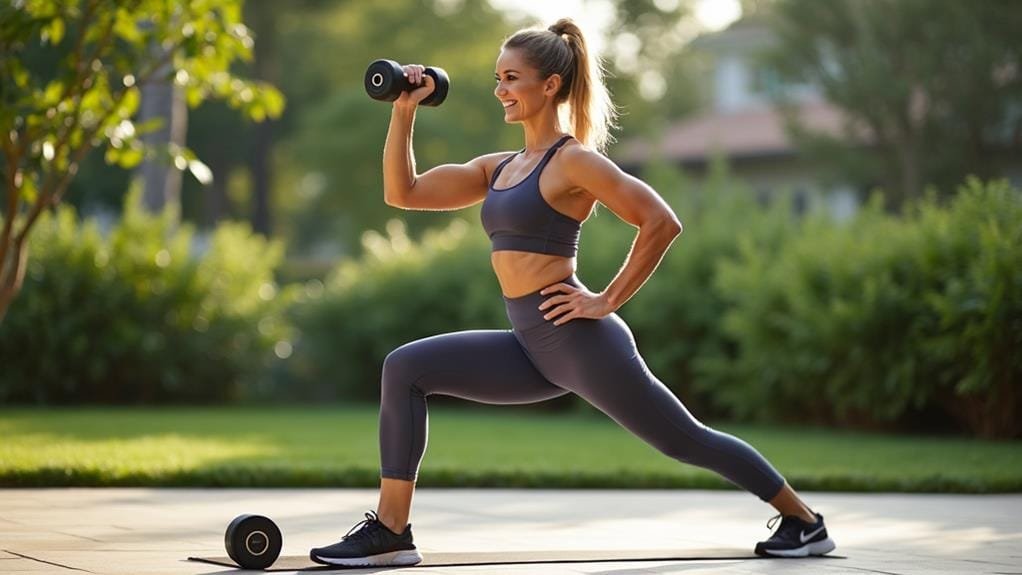After 40, your body undergoes significant changes that affect your metabolism, muscle mass, and bone density, but with a tailored workout routine, you can not only mitigate these changes but also boost your energy, strength, and overall health. You’ll want to focus on functional training, incorporating low-impact exercises like squats and balance training to improve daily tasks and stability. Aim for at least 150 minutes of moderate aerobic activity weekly, along with muscle-strengthening activities twice a week. By creating a balanced routine, you’ll be on your way to a healthier, more vibrant you – and that’s just the beginning!
Key Takeaway
- Women over 40 should focus on strength training to combat the 3-8% decline in muscle mass per decade, accelerating after age 60.
- Incorporate low-impact exercises, such as swimming and gardening, to minimize joint strain and promote cardiovascular health.
- Aim for a balanced routine with at least 150 minutes of moderate aerobic activity and muscle-strengthening activities twice a week.
- Functional training, including squats and balance exercises, improves daily tasks and stability, reducing the risk of falls and injuries.
- Low-impact strength training promotes significant weight loss, boosts energy, and minimizes joint stress, ideal for women with joint issues or recovering from injury.
Physical Changes After 40
As you enter your 40s, subtle yet significant physical changes begin to take hold. Your muscle mass starts to decline, which can affect your overall strength and physical capability. In fact, women typically experience a decline in muscle mass of about 3-8% per decade after age 40, with this loss accelerating after age 60. To combat this, it is crucial to incorporate weight training into your fitness routine. This will help you maintain muscle mass and stay strong.
Hormonal changes, particularly a decrease in estrogen and progesterone, can also lead to increased fat storage around the abdominal area, making weight management more challenging. Additionally, bone mineral density begins to decline in midlife, increasing the risk of osteoporosis and fractures. To mitigate this, focus on weight-bearing exercises, such as squats, lunges, and deadlifts, which will help maintain bone density.
Insulin resistance and thyroid deregulation can slow metabolism and make weight loss more difficult. To overcome this, adjust your exercise intensity and dietary habits. Incorporate high-intensity interval training (HIIT) and strength training to boost your metabolism. You’ll also need to pay closer attention to your diet, focusing on whole, nutrient-dense foods.
Importance of Fitness Assessment
Embracing a proactive approach to your health becomes increasingly vital as you navigate the physical changes that come with aging. A fitness assessment is a significant tool in this journey, helping you identify your strengths and weaknesses in areas such as strength, stability, mobility, and cardiorespiratory fitness. This is particularly important for women over 40, as physiological changes can affect your overall fitness.
Regular evaluations allow you to make informed, tailored training decisions by providing insights into your current fitness levels and areas that require improvement. By monitoring progress and adapting workouts accordingly, you can enhance resilience in body functions, prevent injury, and promote safety. A fitness assessment also helps establish a baseline, informing goal-setting and creating a roadmap for your fitness aspirations.
Here are just a few ways a fitness assessment can benefit your workout routine:
- Helps you set realistic, achievable goals based on your current fitness level
- Identifies areas where you may be at risk for injury, allowing you to take preventative measures
- Enhances motivation and accountability, fostering long-term commitment to a diverse exercise routine
- Allows you to track progress and celebrate successes along the way
Training for Longevity

You’re now ready to shift your focus to training for longevity, where your future fitness aspirations take center stage. As you design your workout routine, you’ll want to incorporate exercises that mimic everyday activities to guarantee you can tackle daily tasks with ease and confidence. By embracing a balanced wellness approach, you’ll set yourself up for long-term success and be empowered to take control of your health and fitness journey.
Future Fitness Aspirations
Many people assume that fitness goals inherently revolve around aesthetics, but for women over 40, shifting the focus to functional mobility and overall well-being is key to training for longevity. As you set your future fitness aspirations, prioritize realistic, long-term goals that promote healthy aging. Engage in low-impact and strength training exercises to preserve muscle mass and bone density, essential for preventing injuries and promoting longevity.
To create a well-rounded workout routine, incorporate activities that support stability and reduce the risk of falls, such as:
- Flexibility exercises to maintain range of motion
- Balance routines to improve overall stability
- Low-impact aerobics to boost cardiovascular health
- Strength training to build muscle and bone density
Tailor your workouts to include enjoyable activities that foster adherence and enhance mental health. Regularly assess your strength, mobility, and endurance to guide adjustments in your training plan, ensuring it remains effective and aligned with your future health goals. By focusing on functional mobility and overall well-being, you’ll be better equipped to maintain independence and enjoy a healthy, active life as you age.
Everyday Activity Exercises
Daily life is filled with opportunities to exercise and train for longevity. You can turn everyday activities into effective exercises that improve your functional fitness, stability, and overall health. Engage in functional exercises like squats and step-ups, which enhance your ability to perform daily tasks and reduce the risk of injury as you age. Incorporate balance training, such as single-leg stands, to maintain stability and prevent falls.

You can also boost your cardiovascular health and weight management by incorporating physical activity into your daily routine. Activities like walking, gardening, and household chores can greatly contribute to your overall daily physical activity levels. Regular low-impact exercises like swimming or cycling provide cardiovascular benefits while being gentle on your joints. Don’t forget to add stretching and flexibility exercises like yoga or Pilates to promote better mobility and core strength. By incorporating these everyday activity exercises into your routine, you’ll be training for longevity and maintaining your fitness after 40. Make the most of your daily activities and turn them into opportunities to exercise and stay healthy.
Balanced Wellness Approach
A well-rounded fitness program is essential for training for longevity, especially after 40. As you age, your body undergoes natural changes that can affect your physical capacity and increase your risk of injury. A balanced wellness approach can help you stay healthy and independent. You’ll want to incorporate a mix of exercises that promote cardiovascular health, strength, flexibility, and balance.
- Engage in functional exercises that mimic everyday movements, such as squats, lunges, and step-ups, to enhance your physical capacity and functional independence.
- Incorporate low-impact, moderate-intensity activities, like cycling or swimming, to manage cortisol levels and maintain joint health.
- Add weight training to your routine to preserve muscle mass and bone density.
- Make time for mind-body practices like yoga or Pilates to foster mental clarity and reduce stress.
Weekly Exercise Guidelines
Now that you’ve committed to fitness after 40, it’s time to create a weekly routine that sets you up for success. You’ll want to set realistic fitness goals that challenge you without pushing your body too hard, craft a balanced routine that includes a mix of cardio, strength training, and flexibility exercises, and schedule rest and recovery days to help your body rebound. By striking this balance, you’ll be able to make consistent progress, reduce your risk of injury, and enjoy the many benefits that come with regular exercise.
Setting Realistic Fitness Goals
To achieve overall health and fitness, you’ll want to set realistic fitness goals that incorporate a balanced mix of activities. Setting realistic fitness goals helps you stay motivated and focused on your journey to a healthier, stronger you.
When setting your goals, consider the following key elements:
- Aim for at least 150 minutes of moderate aerobic activity each week
- Incorporate muscle-strengthening activities on two or more days
- Include flexibility and balance training at least twice a week to enhance mobility and prevent falls
- Prioritize rest and recovery by designating at least one to two rest days each week
As you set your goals, make certain they’re specific, achievable, and aligned with your fitness priorities. Regularly assess your progress, adjusting your goals as needed to guarantee continued motivation and engagement. By setting realistic fitness goals, you’ll be more likely to stick to your routine, celebrate your successes, and make meaningful progress towards a healthier, more vibrant you. With patience, persistence, and the right approach, you can achieve your fitness goals and enjoy the many benefits of a healthy, active lifestyle.
Crafting a Balanced Routine
Your fitness goals are in place, and you’re ready to create a routine that will help you achieve them. To craft a balanced routine, you’ll want to incorporate a mix of exercises that support your overall health and fitness. Aim for at least 150 minutes of moderate aerobic activity each week, such as brisk walking, cycling, or swimming. Complement this with muscle-strengthening exercises, also known as strength training, on two or more days per week. This will help you maintain muscle mass and bone density, which decline with age.
In addition to aerobic exercise and strength training, incorporate flexibility training by stretching major muscle groups at least two times per week. This will help maintain and improve your range of motion, preventing injuries and ensuring you can continue to perform daily activities with ease. Balance activities, such as yoga or Pilates, can also enhance your overall fitness and metabolic health. By incorporating these elements, you’ll be well on your way to creating a well-rounded routine that supports your fitness goals and promotes healthy aging. Remember to prioritize variety and consistency to keep your routine engaging and prevent plateaus.
Scheduling Rest and Recovery
A well-structured exercise routine isn’t complete without scheduled rest and recovery time. As you create your weekly workout schedule, make certain to include rest days to allow your muscles to recover and prevent overuse injuries. You’re not being lazy, you’re being smart! Your body needs time to repair and rebuild muscle tissue, and rest days are essential for this process.
Incorporating active recovery sessions on your rest days can be beneficial. Try gentle yoga, leisurely walking, or other low-intensity activities to promote blood flow and aid muscle healing. Remember, rest days are not a one-size-fits-all approach. Listen to your body and adjust your schedule as needed.
Here are some tips to keep in mind:
- Take at least one full rest day per week, typically Saturday or Sunday.
- Engage in active recovery sessions to promote blood flow and muscle healing.
- Prioritize hydration and proper nutrition during recovery periods.
- If fatigue or soreness persists, consider extending recovery time to guarantee peak performance in subsequent workouts.
Psychological Aspects of Aging

As women enter their 40s, the aging process can bring about a unique set of psychological challenges, including increased anxiety and depression. You may find yourself feeling overwhelmed, struggling to cope with the physical changes that come with aging. However, regular physical activity is a powerful tool in alleviating these symptoms, and it’s important to incorporate fitness into your daily routine.
Setting realistic fitness goals is essential in fostering motivation and enhancing self-efficacy. By achieving small victories, you’ll build confidence and develop a sense of accomplishment, which can translate to other areas of your life. Don’t be too hard on yourself – focus on progress, not perfection. Celebrate your successes, no matter how small they may seem.
Social support is also crucial in maintaining motivation and accountability. Joining a community or group workout can provide a sense of belonging and help you stay on track. You’ll be surrounded by like-minded women who understand the challenges you’re facing, and you can support and motivate each other every step of the way.
Mindfulness practices, such as yoga and meditation, can also enhance your mental health and foster a positive relationship with aging and fitness. By embracing a mindset shift that promotes acceptance of aging, coupled with achievable fitness accomplishments, you can greatly improve your overall well-being and motivation. Remember, fitness is a journey, not a destination. Focus on progress, stay positive, and you’ll be on your way to a healthier, happier you.
Common Exercise Struggles Over 40
As you hit 40, you may find that your trusty old workout routine just isn’t cutting it anymore – and it’s not just a matter of motivation. Physical changes, like hormonal shifts and decreased mobility, can greatly impact your fitness progress, making it tougher to shed those extra pounds and achieve your goals. Your body’s resistance to exercise changes can be especially frustrating, but understanding what’s happening can help you break through the plateau and find a new path to success.
Physical Changes Affect Fitness
Struggling to achieve the same workout results you enjoyed in your younger years can be frustrating, especially when it feels like you’re putting in the same effort. As you age, natural physiological changes can greatly impact your fitness journey. Decreased estrogen levels, for instance, affect fat storage and metabolism, making it vital to adjust your exercise routine.
Your body undergoes various changes after 40 that can influence your workout effectiveness. Consider the following factors:
- Decreased muscle mass, which can start as early as your 30s, reducing overall strength and emphasizing the need for resistance training.
- Increased cortisol sensitivity and insulin resistance, making it essential to manage exercise intensity and frequency.
- Hormonal fluctuations that lead to heightened cravings and satiety issues, complicating weight management goals.
- Greater risk of muscle loss and injury from high-intensity exercises like long-distance cardio.
To overcome these challenges, focus on resistance training to maintain muscle mass and overall strength. By understanding and addressing these physical changes, you can tailor your workout routine to your body’s evolving needs, ensuring a safer and more effective fitness journey. This strategic approach will help you stay motivated and achieve your goals.
Weight Loss Efforts Stall
You’ve been diligently following your workout routine, but the number on the scale refuses to budge. It’s frustrating, especially when you’re putting in the effort and not seeing the weight loss results you want. As a woman over 40, you’re not alone in this struggle.
Natural hormonal shifts, such as decreased estrogen and increased cortisol sensitivity, can affect appetite regulation and fat storage, leading to weight loss plateaus. Additionally, insulin resistance and leptin resistance can heighten feelings of hunger and make it harder to achieve your weight-related goals.
Why Your Weight Loss Efforts May Be Stalling
| Hormonal Shifts | Impact on Weight Loss | Tips to Overcome |
|---|---|---|
| Decreased estrogen | Increased fat storage | Incorporate strength training to build muscle |
| Increased cortisol sensitivity | Elevated hunger and cravings | Practice stress-reducing techniques like yoga or meditation |
| Insulin resistance | Difficulty losing weight | Focus on whole, unprocessed foods and portion control |
| Leptin resistance | Increased hunger and food cravings | Get enough sleep and eat protein-rich foods |
| Metabolic slowdown | Reduced calorie burn | Incorporate high-intensity interval training (HIIT) into your routine |
Don’t give up! By understanding the physiological changes happening in your body and adjusting your workout routine and lifestyle habits, you can break through the weight loss plateau and achieve your fitness goals.
Body Resists Exercise Changes
Because your body undergoes significant changes after 40, it’s not uncommon for your exercise routine to hit a roadblock. You might find that your go-to workouts from your 20s and 30s just aren’t yielding the same results. One major culprit is the natural decline in muscle mass and metabolic rate that occurs with age.
Your body’s increasing cortisol sensitivity can also make it less responsive to weight loss efforts, leading to fat accumulation around the midsection. Additionally, hormonal fluctuations can affect joint health and mobility, making exercise more challenging and increasing the risk of injury.
Some common exercise struggles you may face over 40 include:
- Decreased muscle mass and metabolic rate, making weight loss more difficult
- Increased cortisol sensitivity, leading to fat accumulation around the midsection
- Joint health and mobility issues due to declining estrogen and progesterone levels
- Leptin resistance, making it harder to maintain a balanced diet and regular exercise routine
It’s essential to acknowledge these changes and adapt your fitness routine accordingly. By doing so, you can overcome these challenges and achieve a healthier, more balanced lifestyle. Focus on incorporating strength training to maintain muscle mass and adjusting your workout routine to accommodate joint health.
Physiological Changes Over 40

Midlife brings a host of physiological changes that can impact your fitness journey. As you navigate your 40s, you’ll experience hormonal shifts that lead to decreased estrogen and progesterone levels. This decline affects joint health, muscle mass, and overall metabolism, making it more challenging to maintain a healthy weight. You’ll need to adapt your training to counteract these changes and prioritize strength training to preserve muscle mass.
The decline in muscle mass accelerates after 60, with an estimated loss of 3-8% per decade starting in your 30s. This makes strength training increasingly essential to maintain muscle function and overall health. In addition, you may experience increased cortisol sensitivity and insulin resistance, making it harder to lose weight and increasing cravings for unhealthy foods. To combat this, focus on whole, nutrient-dense foods and incorporate stress-reducing activities into your routine.
As bone mineral density begins to decline, you’ll need to incorporate weight-bearing exercises to maintain strong bones and prevent osteoporosis. This can include activities like walking, running, or weight training. Moreover, your cardiovascular endurance, measured by VO2 max, will decrease, requiring adjustments in your fitness strategy and exercise intensity. By understanding these physiological changes and adapting your training, you’ll be better equipped to navigate the challenges of fitness after 40 and maintain a healthy, active lifestyle. By prioritizing strength training, weight management, and stress reduction, you’ll be on the path to thriving in midlife.
Negative Impacts of High-Intensity Exercises
As you explore high-intensity exercises in your 40s, it is crucial to weigh the potential risks of overexertion, which can lead to injuries and long-term mobility issues. Your joints, in particular, may protest the high-impact activities you enjoyed in your younger years, and ignoring their complaints can have serious consequences. Elevated stress levels, another common side effect of high-intensity workouts, can also sabotage your fitness goals, making it harder to lose weight and maintain motivation.
Risks of Overexertion
While regular exercise is crucial for maintaining fitness after 40, pushing yourself too hard with high-intensity workouts can have unintended consequences. You may be putting your body at risk of overexertion, which can lead to a range of negative effects.
When you overexert yourself, you may experience stress from overexertion, which can hinder your progress and even lead to weight gain. Here are just a few risks to weigh:
- You may lose muscle mass instead of gaining it, which is especially concerning for women over 40 who are already at risk of sarcopenia.
- Elevated cortisol levels can make it harder to lose fat, creating a frustrating cycle.
- If you’re carrying extra weight, high-impact activities can increase your risk of injury, so it’s important to approach exercise with caution.
- Overexertion can also lead to increased cravings and a slower metabolism, making it harder to achieve your fitness goals.
Impact on Joints
Beneath the surface of a well-intentioned fitness routine, high-intensity exercises can be quietly taking a toll on your joints. As you push yourself to new limits, you may not notice the strain on your joints, but the impact can be significant, particularly if you’re carrying excess body weight. High-impact workouts, such as running and HIIT, can cause repetitive stress on your joints, leading to injuries and reduced mobility. This is especially concerning for women over 40, as the natural decline in muscle mass can make joints more vulnerable.
Ignoring the impact on your joints can lead to a cycle of discouragement and decreased physical activity, ultimately affecting your overall fitness and well-being. Additionally, high-impact exercises can exacerbate existing joint health issues, especially in post-menopausal women. To maintain long-term exercise adherence, it’s essential to incorporate low-impact alternatives that prioritize joint health. By being mindful of the impact on your joints, you can create a fitness routine that not only gets you results but also keeps you safe and injury-free. Take control of your fitness journey and prioritize your joint health – your body will thank you!
Elevated Stress Levels
High-intensity exercises can have a profound impact on your body, but it’s not just your joints that bear the brunt. As a woman over 40, you may be surprised to learn that these intense workouts can actually elevate your stress levels, making it harder to achieve your fitness goals. When you engage in high-intensity exercises like HIIT and prolonged cardio sessions, your cortisol levels surge, leading to increased fat storage and difficulty with weight loss.
Here are just a few ways high-intensity exercises can negatively impact your body:
- Elevated cortisol levels can lead to increased fat storage and difficulty with weight loss
- Intense workouts can exacerbate the body’s stress response, resulting in fatigue and reduced motivation to exercise
- Prolonged high-impact cardio can lead to muscle loss and joint injuries, causing frustration and discouragement
- The combination of added stress from high-intensity exercise and hormonal changes around menopause can complicate recovery and negatively impact body composition
It’s time to rethink your approach to fitness. By focusing on lower-impact activities, you can mitigate stress levels and promote sustainable, long-term fitness routines that nourish your body, rather than depleting it. Make the shift and start seeing the positive impact on your overall well-being.
Optimal Exercise Strategies

Someone hitting 40 might think it’s time to slow down, but the opposite is true when it comes to fitness. As you enter this new decade, you’ll want to focus on ideal exercise strategies that cater to your changing needs. For female fitness after 40, it’s important to prioritize low-impact exercises that minimize joint strain while preserving muscle mass and enhancing bone density. In addition to low-impact exercises, women over 40 should also consider incorporating flexibility and balance training into their fitness routine to reduce the risk of injuries. It’s also important to work with a qualified fitness professional to develop a customized postpartum fitness plan if you’ve had children, to address any specific physical changes that may have occurred after childbirth. By focusing on a holistic approach to fitness, women can maintain their health and well-being well into their 40s and beyond.
You’ll want to incorporate resistance training at least twice a week to combat sarcopenia and maintain metabolic health. Aim for sessions lasting around 30 minutes for effective results. Don’t be afraid to challenge yourself, but also listen to your body and adjust the intensity and volume of your workouts accordingly. When it comes to cardiovascular fitness, combine workouts with intervals of higher intensity for improved aerobic fitness and weight management. Aim for at least 150 minutes of moderate activity weekly.
To prevent falls and enhance mobility, prioritize balance and flexibility exercises, integrating routines at least twice a week. It’s also vital to tailor your workouts based on individual fitness assessments to address specific strengths and weaknesses. This will allow for more effective and safer exercise strategies post-40. By incorporating these ideal exercise strategies into your routine, you’ll be well on your way to achieving a strong, healthy, and balanced body. Remember to consult with a healthcare professional before starting any new exercise program, especially if you have any underlying medical conditions or concerns.
Benefits of Low-Impact Strength Training
As you consider your fitness options after 40, you may be thinking about incorporating strength training into your routine. Low-impact strength training (LIST) is an excellent choice, as it minimizes joint stress and enhances muscle toning, making it perfect for women who may be experiencing joint issues or recovering from injuries. By engaging in LIST, you can achieve significant weight loss, even with a minimal time commitment to workouts.
The benefits of LIST go beyond weight loss. This type of training promotes increased muscle mass, which elevates your metabolism and enhances caloric burn throughout the day, aiding in weight management post-40. You can conveniently execute LIST at home, allowing greater accessibility and adherence for busy women. Here are just a few benefits you can expect from incorporating LIST into your routine:
- Increased muscle mass and tone
- Enhanced metabolism and caloric burn
- Improved physical strength and physique
- Boosted energy levels and mood enhancements due to the release of endorphins
Benefits of Weight Loss

Kicking off your weight loss journey after 40 can have a profound impact on your overall health. As you lose weight, you’ll notice improvements in your blood pressure, cholesterol, and blood sugar levels, all contributing to a healthier cardiovascular system. A modest weight loss of 5-10% is all it takes to start seeing significant benefits.
Losing weight also reduces your risk of chronic diseases like type 2 diabetes and heart disease, which are more prevalent in women over 40. By shedding those extra pounds, you’ll be taking a proactive approach to protecting your long-term health. Plus, you’ll experience a boost in energy levels and an overall improvement in your quality of life. Weight loss can even enhance your body image and self-esteem, giving you a fresh new perspective on life.
Achieving a healthy weight also takes pressure off your joints, improving mobility and reducing discomfort. This is essential for ongoing physical activity and will make it easier to stick to your workout routine. Additionally, engaging in weight loss through exercise, particularly weight-bearing activities, helps maintain bone density and lower the risk of osteoporosis as you age. As you lose weight, you’ll feel more confident and capable, both physically and mentally. So, take the first step towards a healthier, happier you and start working towards your weight loss goals today. You’ve got this.
Creating a Balanced Workout Routine
Beyond the numerous benefits of weight loss, creating a balanced workout routine is essential for women over 40 who want to maintain overall fitness and health. As you age, your body undergoes various physical changes that can affect your mobility, balance, and cardiovascular health. A well-rounded workout routine can help you address these changes and stay active, healthy, and independent.
A balanced workout routine should combine cardiovascular exercise, resistance training, flexibility routines, and balance training. Aim for at least 150 minutes of moderate aerobic activity weekly, alongside muscle-strengthening activities on two or more days. This will not only promote overall fitness and weight management but also reduce the risk of chronic diseases.
Incorporate low-impact exercises, such as swimming or cycling, to prevent joint strain while still providing cardiovascular benefits. These exercises are ideal for maintaining an active lifestyle post-40.
Some essential components of a balanced workout routine include:
- Cardiovascular exercise, such as brisk walking, jogging, or dancing, to improve heart health and burn calories
- Resistance training, such as weightlifting or bodyweight exercises, to build muscle and boost metabolism
- Flexibility routines, such as yoga or Pilates, to enhance mobility and improve posture
- Balance training, such as single-leg stands or stability ball movements, to reduce the risk of falls
Nutrition and Fitness Over 40

Now that you’ve got a solid workout routine in place, it’s time to fuel your body for peak performance. As you exercise and push yourself to new fitness heights, you’ll want to make sure you’re giving your body the nutrients it needs to recover, adapt, and burn fat efficiently. For women over 40, this means paying special attention to protein intake. As muscle mass naturally declines with age, increasing protein can help support muscle repair and growth.
A balanced diet rich in fruits, vegetables, and whole grains is also vital for overall health, helping to combat the reduced metabolic rate often seen in midlife. Be mindful of your caloric intake, as hormonal changes can lead to insulin resistance and weight gain, particularly around the abdomen. Staying hydrated is essential too, as reduced thirst sensitivity in older adults can make it harder to stay on top of your water intake. Drinking water regularly will help maintain energy levels and overall well-being.
Consider adding nutritional supplements like Vitamin D and Omega-3 to your routine, as they can help address common dietary gaps and support joint health and inflammation management. By fueling your body with the right nutrients, you’ll be able to power through your workouts, support your overall health, and achieve your fitness goals. Remember, exercise and nutrition go hand-in-hand – by combining a balanced diet with regular exercise, you’ll be unstoppable!
Maintaining Motivation and Consistency
Staying on track with your fitness routine can be a challenge, especially when life gets in the way. But don’t worry, you’re not alone! Maintaining motivation and consistency is a common struggle many women face, especially after 40. The good news is that there are many strategies that can help.
One of the most effective ways to stay motivated is to set realistic fitness goals. Break down larger objectives into smaller, achievable milestones, and celebrate your successes along the way. This will help you stay engaged and motivated, even when the going gets tough.
Here are some additional tips to help you maintain motivation and consistency:
- Join a community or group workout, such as a fitness class tailored for women over 40. This will provide social support and accountability, and make exercise more enjoyable.
- Track your progress through metrics or journaling. Seeing your achievements in black and white can be a powerful motivator.
- Incorporate variety in your workout routine, including resistance training, cardio, and flexibility exercises. This will prevent boredom and keep you engaged.
- Schedule your exercise sessions as appointments in your calendar, and treat them as non-negotiable.
Frequently Asked Questions
What Is the Ideal Workout Schedule for Women Over 40?
You’ll want to create a workout schedule that includes strength training exercises at least two days a week, with at least 150 minutes of moderate aerobic activity, and rest days to allow your muscles to recover safely.
How Many Times a Week Should a 40 Year Old Woman Workout?
As you ignite your fitness journey, aim to workout 3-5 times a week, with strength training sessions 2-3 times, allowing for rest days to kindle recovery and prevent injury, ensuring a safe and balanced routine.
How Can a Woman Get Fit After 40?
You can get fit after 40 by adopting a mindset transformation, focusing on progress, not perfection, and committing to regular exercise, including strength training, cardio, and flexibility exercises, while prioritizing a balanced diet and adequate recovery.
How Much Exercise Does a 40 Year Old Woman Need?
As you hit 40, you need at least 150 minutes of moderate aerobic exercise and strength training on two or more days a week, incorporating high-intensity intervals and flexibility exercises to maintain mobility and overall health.





